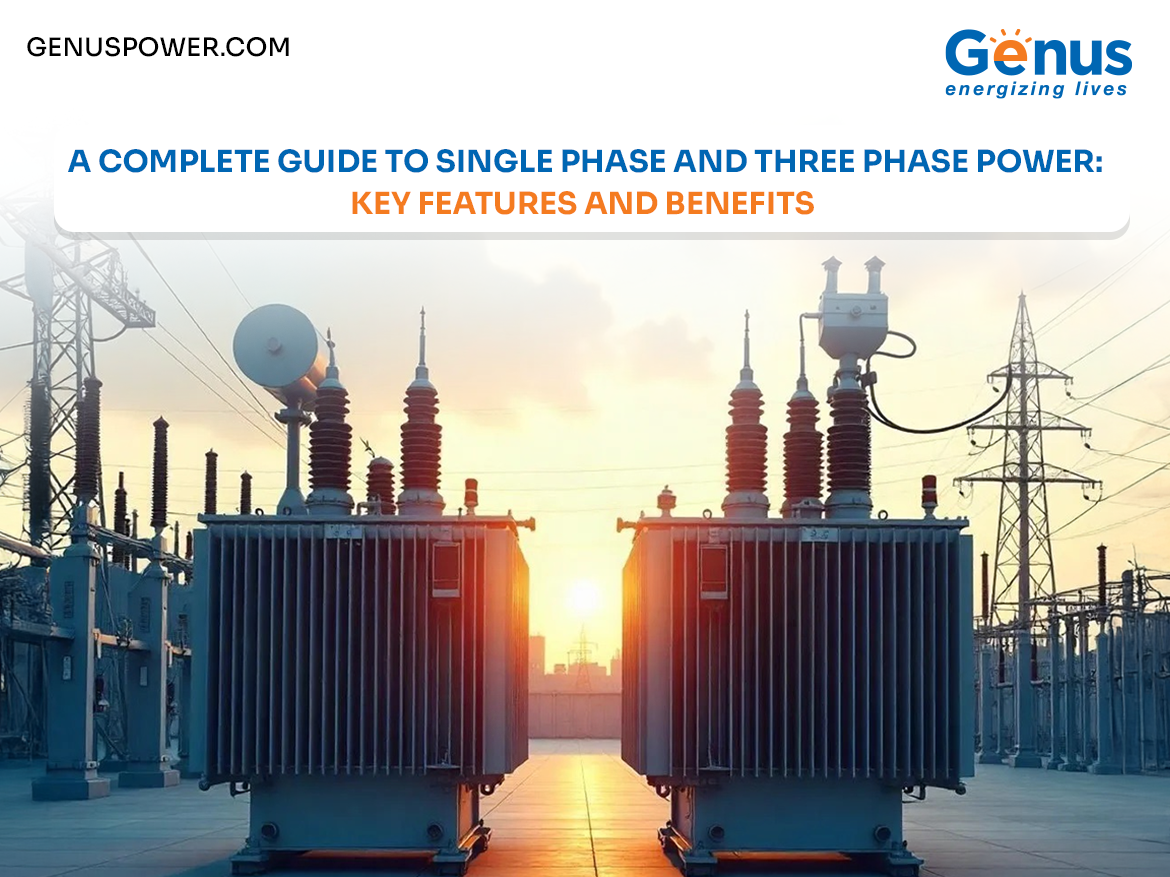
Electrical phases define how loads are distributed across the network. A single phase circuit uses two wires – one hot conductor and one neutral, while three-phase power employs three conductors, delivering smoother, higher-capacity power.
Residential environments usually rely on single-phase supplies for lighting and heating loads, but commercial and industrial facilities leverage three phase power to run large motors and heavy equipment.
Accurate metering, from basic load sensors to advanced distribution transformer metering solutions, is crucial for detecting phase imbalances, ensuring billing accuracy, and enabling proactive maintenance.
In the following sections, we’ll explore the characteristics of each power architecture, compare their performance, and highlight best practices in metering to optimize efficiency and reliability.
Single-Phase Power and Its Features
A single-phase power supply consists of a single alternating current (AC) waveform, typically delivered as one “hot” conductor and a neutral conductor. This setup is what most homes and small businesses use.
- Voltage Profile: Usually 120V or 230V in domestic settings.
- Waveform: One sine wave cycle delivers power; when the voltage crosses zero, there’s a brief power dip.
- Applications: Lighting, small motors, household appliances. Think refrigerators, TVs, and laptops.
- Simplicity & Cost: Installation and equipment costs are lower than those of three-phase systems. Wiring is straightforward, and consumer-grade meters are widely available.
- Limitations: Power delivery has peaks and troughs. Large motors may overheat or stall under heavy loads.
Because the waveform oscillates between positive and negative, you might notice dimming lights or slower motor starts under heavy demand. Yet for many applications, the Single Phase option remains economical and sufficient.
Three-Phase Power and Its Features
In a three-phase power system, three separate AC waveforms are offset by 120° from each other. This creates a more balanced and continuous power flow.
- Voltage Profile: Commonly 400V to 480V line-to-line in industrial settings.
- Waveform Continuity: At least one phase is always near its peak, so power never drops to zero.
- Applications: Large motors, heavy machinery, data centers, and any load requiring smooth torque or high power.
- Efficiency & Capacity: Can transmit more power using smaller conductors compared to three separate single-phase lines.
- Stability: Reduces vibration in motors and provides consistent operation even under fluctuating loads.
With three-phase supplies, equipment operates more efficiently, starts up more smoothly, and experiences less downtime. For any facility operating industrial-grade equipment, the benefits quickly outweigh the added complexity and cost.
Single Phase vs. Three Phase Power
While a single-phase system delivers power through one live conductor and a neutral return path, three-phase power harnesses three equally spaced waveforms, offering fundamental differences:
- Power Consistency. Single-phase experiences power peaks and zero crossings with each AC cycle, resulting in pulsating torque and voltage dips under heavy load. By contrast, three-phase power maintains constant power transfer, since at least one phase is always near peak voltage.
- Load Capacity. Domestic loads like lighting, heating elements align well with single-phase limits. Industrial motors and high-demand equipment, however, require the higher power density of three-phase power to start smoothly and run efficiently.
- Conductor Sizing. To support equivalent loads, a single-phase circuit needs larger conductors to handle current surges. Three-phase power systems split current across three wires, enabling smaller conductors and reduced copper usage.
- Equipment Performance. Motors on three-phase power deliver uniform torque, lower vibration, and longer lifespan. In single-phase setups, motor starters often require additional capacitors or complex drive electronics.
- Scalability and Flexibility. While you can derive a single-phase feed from a three-phase power network using transformers, the reverse is not feasible. Facilities planning growth typically installs three-phase power to future-proof their infrastructure.
This side-by-side comparison underscores why selecting between single-phase and three-phase power hinges on load profile, efficiency goals, and capital investment.
Importance of Three-Phase Meter and Distribution Transformer Metering
When you deploy three-phase power, accurate metering becomes mission-critical. Here’s why:
- Fair Billing & Load Monitoring: A 3-phase meter records each phase’s consumption, ensuring you’re billed correctly and identifying phase imbalances before they cause damage.
- Phase Balancing: Imbalances can overheat transformers or motors. Smart metering flags skewed loads in real time, enabling corrective action.
- Preventive Maintenance: Advanced distribution transformer metering systems track voltage drops, harmonic distortions, and load spikes, data that’s invaluable for scheduling maintenance before failures occur.
- Energy Efficiency: With clear insights from 3-phase meters and distribution transformer metering, you can optimize peak load times, shift non-critical operations, and reduce demand charges.
- Regulatory Compliance: Many regions mandate precise energy audits. Reliable 3-phase metering supports both internal sustainability goals and statutory reporting.
By integrating high-accuracy 3-phase meters with robust distribution transformer metering, utilities and end users can unlock a new layer of transparency, efficiency, and system resilience.
Parting Thoughts
Choosing between single-phase and three-phase power boils down to understanding your load, budget, and operational priorities. For light usage, Single Phase offers simplicity and cost advantages.
Yet as soon as you require continuous power, balanced motor performance, or higher capacity, three-phase power and proper metering, including advanced Distribution transformer metering, becomes indispensable.
Armed with this guide, you’re now ready to specify the right supply, advocate for smart metering solutions, and ensure your installations run smoothly for years to come. At Genus, we empower homes and industries with advanced metering solutions that perfectly match the needs of single and three-phase power systems. For more information on our products and solutions, please visit our website or get in touch with our experts.
